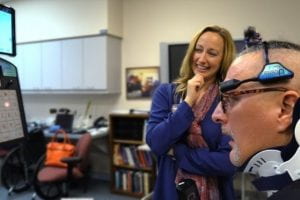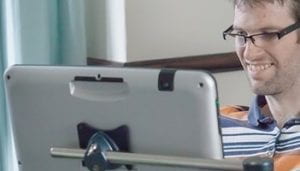 In a recent podcast for Speech Uncensored, Dr. Susan Fager discussed her research on access and communication technology, and how the work she is completing translates to clinical practice. Susan also covered the progression from low tech to high tech AAC that a patient may experience across their recovery stages. Dr. Fager provided case studies to illustrate creative problem solving and overcoming obstacles to provide patients with a means to express themselves.
In a recent podcast for Speech Uncensored, Dr. Susan Fager discussed her research on access and communication technology, and how the work she is completing translates to clinical practice. Susan also covered the progression from low tech to high tech AAC that a patient may experience across their recovery stages. Dr. Fager provided case studies to illustrate creative problem solving and overcoming obstacles to provide patients with a means to express themselves.
Supporting Communication of Individuals with Minimal Movement
- Transcript of presentation (pdf)
- Transcript of presentation (txt)
- Powerpoint slides as a handout (pdf)
This webcast was produced as part of the work of the AAC-RERC under grant #H133E080011 from the National Institute on Disability and Rehabilitation Research (NIDRR)in the U.S. Department of Education’s Office of Special Education and Rehabilitative Services (OSERS)
“Barely getting warmed up”: My use of AAC to achieve big bold dreams
Webcast description
Godfrey Nazareth describes his use of AAC to pursue his goals in work and society
First shown at the RERC on AAC State of the Science Conference in Arlington, Va, on July 13, 2018.
Text and photos by Godfrey Nazareth (video editing by David McNaughton)
Please cite as:
Nazareth, G. (2018, July 13). “Barely getting warmed up”: My use of AAC to pursue big bold dreams. Retrieved from https://aac-learning-center.psu.edu/2018/10/10/barely-getting-warmed-up-my-use-of-aac-to-achieve-big-bold-dreams
Additional resources
The sky is only the beginning: Living life without limits (webcast)
The sky is only the beginning: Living life without limits
Godfrey Nazareth
Webcast Description
Godfrey Nazareth is a biomedical engineer who makes use of AAC to communicate with others. In this presentation (including a question and answer session) with a graduate class in augmentative and alternative communication at Penn State University, Godfrey describes his experiences as a person with a diagnosis of ALS, and his use of AAC to support his life as a husband, a father, a medical researcher, avionics expert, and airplane pilot.
Godfrey is also a co-leader of the RERC on AAC Dissemination and Training Team, and has played a key role in the RERC on AAC Student Research and Design Competition.
Additional Resources
Communication support for People with ALS
 Beukelman, D., Fager, S., & Nordness, A. (2011). Communication support for people with ALS. Neurology Research International, 2011.
Beukelman, D., Fager, S., & Nordness, A. (2011). Communication support for people with ALS. Neurology Research International, 2011.
http://dx.doi.org/10.1155/2011/714693
Almost all people with amyotrophic lateral sclerosis (ALS) experience a motor speech disorder, such as dysarthria, as the disease progresses. At some point, 80 to of people with ALS are unable to meet their daily communication needs using natural speech. Unfortunately, once intelligibility begins to decrease, speech performance often deteriorates so rapidly that there is little time to implement an appropriate augmentative and alternative communication (AAC) intervention; therefore, appropriate timing of referral for AAC assessment and intervention continues to be a most important clinical decision-making issue. AAC acceptance and use have increased considerably during the past decade. Many people use AAC until within a few weeks of their deaths.